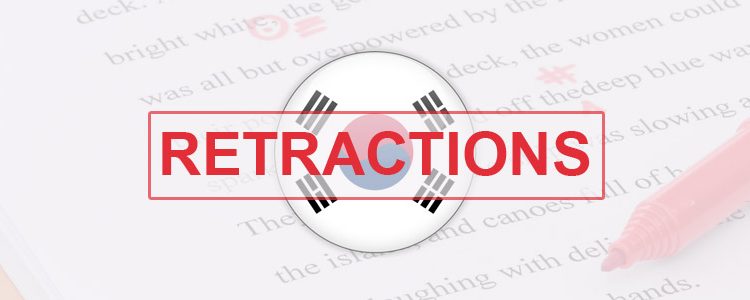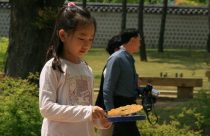Rise of Article Retractions in South Korea

Since its inception in 1997, the Committee on Publication Ethics (COPE) has grown into an international body that offers guidance to journal editors, publishers, and peer-reviewers in the field of academic research. In particular, COPE provides a framework and the resources needed for editors who are making decisions regarding potential misconduct and article retractions. COPE has the potential for offering a reliable and equitable means to assess fraud and misconduct in the global science community. According to COPE, an article should be retracted if:
a) The data is unreliable
b) The data has already been published, either by the same author(s) or by others (plagiarism), or
c) The data constitutes unethical research.
Following a retraction, the notice of the retraction should be linked to the article, published immediately, and be available to all. Notices should include the reason for retraction, the parties issuing the retraction, and be published in all versions (print and/or online) of the article.
Retractions from South Korean Researchers
Recently, some retractions have come from three sets of South Korean researchers:
- Jae Hyo Park & Seung Ki Joo of Seoul National University both of whom retracted five articles from four different journals because it was discovered that they had either duplicated data from a previous article or had used fraudulent data.
- Tsolmonbaatar Batbileg, et al, published an article in the Korean Journal of Chemical Engineering. The article was based on work he had done with his professor, Jong Moon Park, and had published it without the professor’s knowledge or permission. Neither did he consult with other researchers from the project. In addition, the article contained fabricated data and plagiarized material. As he was named on Batbileg’s article, Park initiated the retraction.
- Hyun Chul Lee of Yonsei University in Seoul, South Korea. The story behind the retraction of Hyun Chul Lee’s article is rather more convoluted. It highlights the power of politics, egos, and competitive misdeeds that can go on in the high-minded world of academic publishing. An investigative committee from Yonsei University found apparent duplication of figures and also could not confirm if the key construct existed when the experiment was carried out. The committee also discovered fraudulent use and manipulation of data. The case also reports threats, firings, and blackmail among researchers.
Retractions on the Rise
It has been reported that retractions have been on the rise in recent years. However, according to an article in Vox, it states that the overall number of papers retracted is generally quite low and out of about 1.4 million scientific research papers that are published each year, only about 500 papers get retracted which is about 0.04 percent. Most articles are retracted for reasons of misconduct.
Given the potential damage to an author’s reputation, one wonders why scientists would knowingly attempt to publish material that was either fraudulent or plagiarized. However, there may be several reasons for this:
- Pressure to publish: Most colleges and universities require some form of yearly, published scholarship from tenured or tenure-track professors
- Time constraints: Authors may rush the research process to meet publication deadlines or to claim favorable results ahead of competitors in the same field
- Political pressures and in-fighting: As in the Yonsei University case, researchers may be uncooperative or deceptive in their dealings with one another
- Peer review flaws: Reviewers may put the established reputation of a researcher ahead of rigorous, critical review or merely assume that the data is valid
- Money: Researchers are under enormous pressure to publish in order to bring prestige and, therefore, research funding to themselves or their institutions
In addition, the introduction of plagiarism and image fraud detection tools and software has aided reviewers in their attempts to identify deceptive research and may be partially responsible for the rise in retractions.
Preventing the Publication of Bad Research
Preventing bad research from being published will only become easier as more editors and reviewers utilize the resources provided by COPE and the tools mentioned above. Although it is not useful for reviewers to approach each research article with the assumption that fraud may be lurking within the data, a rigorous, critical mindset will both prevent fraud and assist authors in identifying unintended errors.
Universities and directors of research institutions can also do their part by placing less emphasis on the volume of articles published and more on the quality and long-term relevance of published research. As it is, academic publishing is set up as a sort of citation arms race, creating an unhealthy atmosphere for researchers and undue pressure on young researchers trying to establish their careers.
To assist researchers, the US National Library of Medicine, a division of the National Institutes of Health, has published a list of best practices, taken from the Oman Medical Journal:
- Be aware of the principles of good research practice.
- Ensure adequate supervision by an experienced researcher.
- Perform a literature search to ensure that the research question has not already been answered.
- Obtain early statistical advice.
- Prepare a detailed protocol of proposed research.
- Peer review of the study is mandatory.
- Obtain ethical approval and informed consent.
- Keep detailed, contemporaneous records of research.
- Ensure compliance with the Data Protection Act.
- Always backup computer records.
- Ensure research projects can be completed within an achievable timeframe.
- Submit completed research for publication, ideally in a peer-reviewed journal.
The South Korean science community is just one of the global communities of scientists that have had articles retracted. Fraud and misconduct in science are not an issue attributable to one nation alone. And it can be abated by 1) journal editors and reviewers using fraud detection resources and tools, as well as their own discretion and expertise, 2) authors following strict codes of conduct and guidelines for valid research, and 3) universities and research institutions easing up on the pressure to publish.








